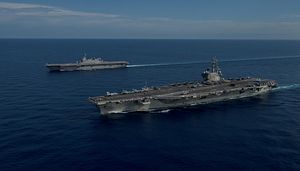The Japan Maritime Self-Defense Force (JMSDF) is slated to dispatch one its largest warships, the Izumo-class helicopter carrier JS Kaga, to the South China Sea and Indian Ocean for a two-month patrol beginning in September to bolster Tokyo’s naval presence in the strategically important waters, according to two Japanese officials who spoke to Reuters on the condition of anonymity this week.
This marks the second straight year that Japan has sent one of its largest warships to the contested maritime region. Last year, the helicopter carrier JS Izumo, the lead ship of the Izumo-class, and the Takanami-class guided-missile destroyer JS Sazanami conducted drills with the U.S. Navy in the South China Sea including a three-day exercise with the Nimitz-class nuclear-powered aircraft carrier USS Ronald Reagan.
The JS Izumo also cruised the Indian Ocean during its months-long deployment to Southeast Asia and took part in the 2017 iteration of the Malabar naval exercise in the Bay of Bengal, which involved naval forces of India, Japan, and the United States. (The exercise for the first time involved aircraft carriers from all three navies.)
“This is part of Japan’s efforts to promote a free and open Indo-Pacific,” a Japanese official told Reuters this week. Japan, however, has so far refrained from participating in so-called freedom of navigation operations in the South China Sea conducted by the U.S. Navy and other U.S. allies. Tokyo fears that doing so could provoke Beijing and led to an increased Chinese naval presence in the East China Sea where both countries are locked in a territorial dispute over the ownership of uninhabited islands.
Japan’s Ministry of Defense has so far not publicly confirmed the deployment of the JS Kaga to the South China Sea or the Indian Ocean.
The 248-meter long Kaga and 27,000-ton heavy JS Kaga was commissioned in March 2017. Along with its sister ship Izumo, the Kaga is one of the biggest surface warships operated by Japanese naval forces since the end of World War II. While the JMSDF officially classified the warships’ as helicopter destroyers in order to downplay the carrier class’ offensive capabilities, the flattops have reportedly been designed to operate short take-off and vertical landing (STOVL) fighters such as Lockheed Martin’s F-35B. This, however, would require a number of modifications as I pointed out earlier this year.
The JMSDF primarily sees the Izumo-class as an anti-submarine warfare platform as the carrier is fitted with a powerful wOQQ-22 bow-mounted sonar and can accommodate a large number of Japan’s most advanced sub-hunting helicopter. “The ship is designed to accommodate up to 14 helicopters (seven Mitsubishi-built SH-60k ASW helicopters and seven Agusta Westland MCM-101 mine countermeasure helicopters), five of which can simultaneously take off and land, given the Izumo’s large flight deck and five landing spots,” I explained previously.
Should the Izumo-class undergo modifications to accommodate the F-35B, the flattop’s anti-submarine warfare capabilities would need to be reduced.

































